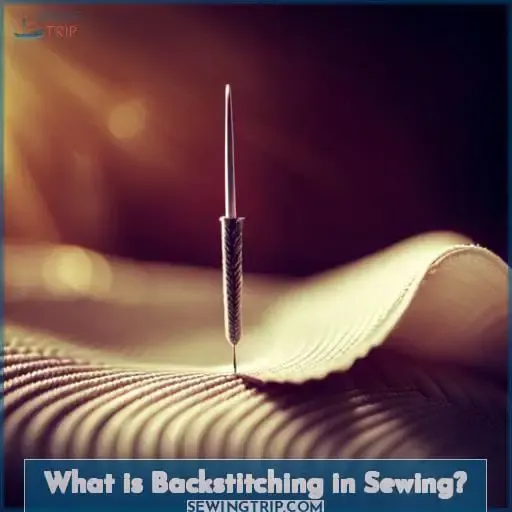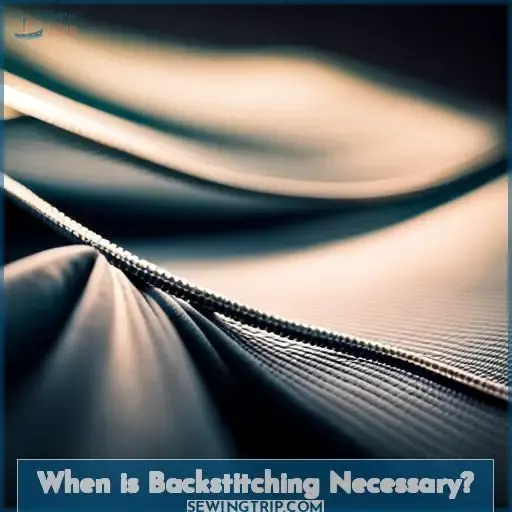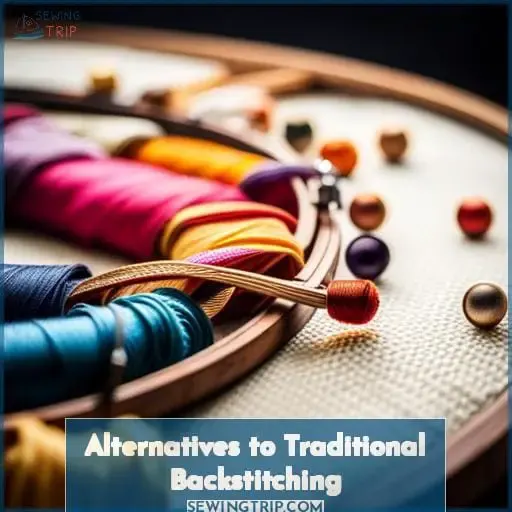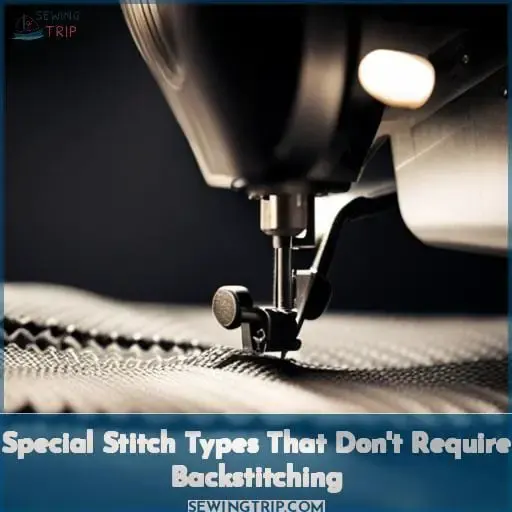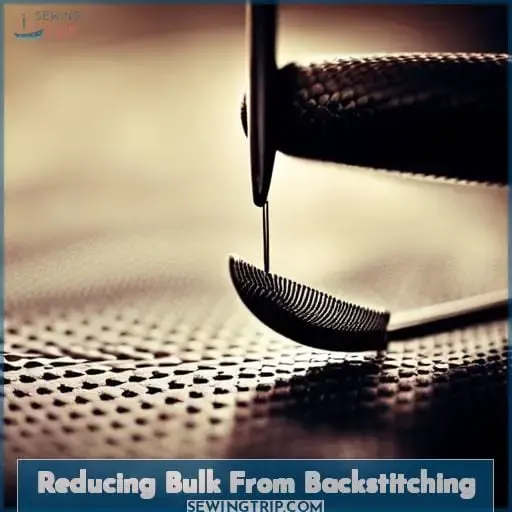This site is supported by our readers. We may earn a commission, at no cost to you, if you purchase through links.
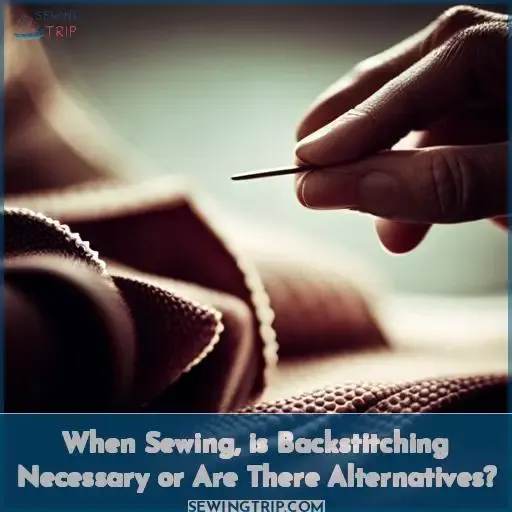
Yet viable alternatives exist to secure your stitching while maintaining drape and flow.
This arsenal of options puts control back in your hands.
Simply try these techniques – from abbreviated lock stitches to clean finishes with specialty feet – and experience the freedom to ditch compulsory backstitching once and for all.
Table Of Contents
Key Takeaways
- Backstitching provides seam security by locking stitches in place, preventing unraveling and seam popping.
- Creative sewers can minimize bulk from backstitching through methods like lock stitches, knotting thread ends, specialty stitches, trimming seam allowances, and more.
- Not all seams require traditional backstitching – knits, finished seam ends, and low-stress seams may permit backstitching alternatives.
- Proper backstitching technique involves only 2-3 reverse stitches at the start and end of seaming for security without excess bulk.
What is Backstitching in Sewing?
When you’re sewing, backstitching involves going back over the stitching line to secure the threads and prevent unraveling.
By sewing a few stitches backward at the start and end of a seam, you lock the threads in place so they can’t come undone, no matter how much stress that area undergoes.
Early sewing machines couldn’t backstitch, so sewers had to turn the fabric around and stitch back over the line.
Today’s machines have backstitch levers to easily reverse stitch without contorting the material.
While backstitching is the standard for securing seams, creative sewers employ shortcuts like tiny knots or angled trims to reduce bulk.
With the right techniques, you can wield liberating power over frayed threads and pursue seam mastery.
When is Backstitching Necessary?
When sewing, determining if backstitching is necessary depends on the type of seam and whether it may unravel.
You typically want to backstitch darts, tucks, pleats, and any seams that won’t be crossed by another seam in order to secure them and prevent unraveling.
However, for seams that will be encased, backstitching may be skipped if the ends are knotted or secured with an extra stitch or two.
Securing Seams
You’re backstitching to secure seams that may unravel or come apart under stress, like waist seams or sleeve caps.
Thread knots at start and end.
Short stitches instead of backstitching.
Reinforce with stay tape inside seam allowance.
Backstitching prevents seams from popping open under stress. Alternative techniques like knotting thread ends or using short lock stitches also secure threads without adding bulk. Strategic reinforcement prevents stretched seams. Evaluate each seam’s stress and customize the securing method.
Preventing Unraveling
Stitches need proper securing to prevent unraveling. Backstitching is one way to do this, but it can add bulk. Knotting thread ends or using short lock stitches secures seams while reducing bulk. Overcasting and zigzag stitches also eliminate the need to backstitch. Specialty stitches offer unraveling prevention, but traditional seams require a backstitch or alternative finishing.
| Method | Benefits | Drawbacks |
|---|---|---|
| Backstitching | Secures seams | Adds bulk |
| Knotting | No bulk | Time-consuming |
| Short stitches | Reduces bulk | Must remember settings |
Alternatives to Traditional Backstitching
You can secure your seams without creating a bulky backstitch.
Try using short lock stitches at the start and end of seams instead.
Knotting thread ends is another simple alternative that locks stitches in place.
Short Lock Stitches
By stitching several short stitches at the start and end of a seam, you’re securing threads without creating unnecessary bulk. Opt for a stitch length of 18-20 per inch. Test different settings on fabric scraps, marking lines to count stitches.
Shortening stitch length locks stitches in place, eliminating backstitching’s unsightly bulk and homemade appearance.
Combine with pressing seams open and grading seam allowances – trimming one allowance slightly narrower.
Utilize these professional finishing techniques for crisper garments.
Knotting Thread Ends
You can tie off your threads in small knots rather than backstitching your seams. Knotting thread ends saves time over traditional backstitching methods while still securing threads.
Simply tie a double knot at the start and end of stitching lines, leaving thread tails long enough to knot securely.
Reinforce knots by stitching over them briefly before clipping threads.
When choosing stitch lengths, opt for shorter stitches near knots to prevent seam gaps if knots loosen unexpectedly.
Knotting gives you more seam finishing options without machine backstitching constraints.
Special Stitch Types That Don’t Require Backstitching
When using zigzag or overcast stitches, you don’t need to backstitch.
These side-to-side stitches are less prone to unraveling under stress.
Instead, rely on the inherent properties of these stitches to prevent your seams from coming undone.
Zigzag Stitches
These stitches don’t need your backstitching since they’re less likely to unravel under stress.
- Zigzag stitching moves side to side, locking threads in place.
- Great for knits and stretch fabrics.
- Use narrow zigzag on sheer fabrics to reduce bulk.
- Try a triple zigzag for extra strength without bulk.
- Finish seams with a zigzag stitch instead of backstitching.
Overcasting Stitches
When stitching edges, you’re able to skip backstitching thanks to overcast stitches not unraveling under stress. These versatile stitches finish raw edges, preventing fraying without securing thread ends.
| Stitch Type | Description | Best Uses |
|---|---|---|
| Zigzag | Side-to-side stitch prevents unraveling | Seam allowances, hem edges |
| Overlock | Encases edge with thread | Knit hems, necklines |
| Rolled Hem | Tiny hem using needle and looper threads | Lightweight sheer fabrics |
Zigzag Stitches
Reducing Bulk From Backstitching
To reduce the bulk caused by backstitching, you can focus on two techniques:
- Pressing seams and grading seam allowances.
Pressing seams open before trimming the seam allowance allows for a sharper and cleaner finish, while sandwiched pressing sets the stitches for a more professional look.
Grading the seam allowance by trimming one slightly less than the other reduces bulk and helps achieve a flat outside appearance.
Pressing Seams
- Sandwiching seams between two pressing cloths while pressing with the tip of a hot iron ensures seams lie perfectly flat for a crisp, clean finish.
To reduce bulk from backstitching:
- Press seams open before trimming
- Use the tip of the iron along stitching
- Grade seam allowances
- Choose an appropriate stitch length
Grading Seam Allowances
Since pressing seams open helps reduce bulk, you’ll also want to consider grading the seam allowances.
| A simple way is angling the scissors when trimming both together. Or use duckbill scissors specialized for seam grading. The narrower allowance will lay flatter against the garment. Method | Description |
|---|
Angled Trimming
Duckbill Scissors
Frequently Asked Questions (FAQs)
Is backstitching necessary when sewing knit fabrics?
When sewing knits, backstitching is usually unnecessary.
Knit fabrics have natural stretch and recovery, so seams are less likely to unravel even without backstitches.
Simply tie knots at the seam ends instead for security.
How can I reinforce the end of a seam without backstitching?
Stitch several small stitches close together at the seam’s end.
Lower the fabric feed dogs.
This locks stitches firmly without bulk.
What size stitches should I use when backstitching by hand?
When hand sewing, use small stitches (16-18 per inch) for backstitching.
This will reinforce seams securely without excessive bulk.
Can I eliminate backstitching if I’m using a serger?
Backstitching can often be avoided when using a serger.
Simply stitch past the fabric end, flip work over, serge an inch back, then exit the seam at an angle.
This secures threads while eliminating unnecessary bulk and visible knots for a cleaner finish.
I suggest testing on scraps first before sewing your project.
How many backstitches are needed at the start and end of a seam?
You need just 2-3 backstitches at the start and end to secure your seams.
More creates unnecessary bulk and an amateurish look.
Simply reduce your stitch length to 18-20 spi instead.
This locks stitches securely without bulk.
Experiment on scrap fabric if unsure.
Your technique will quickly improve.
Conclusion
Like a skilled sewer cutting a precise seam allowance, you now grasp alternatives to excess backstitching that ensure durability without forfeiting elegance.
Let specialty stitches contour the fabric’s personalized spirit as graceful curves or graphic geometry.
Secure subtle strength into seams with abbreviated locks rather than needless bulk.
Whether modern minimalism or avant couture, implement these techniques for garments that honor our era’s ethos: quality craftsmanship fused with freedom of movement.
Moving forward, may bold yet thoughtful construction guide your needle and thread.

